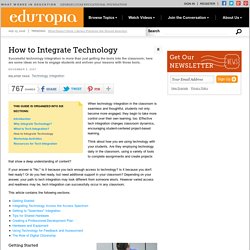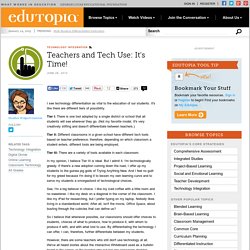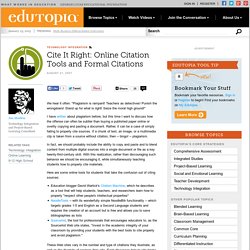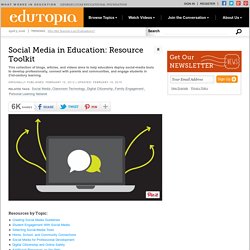

An Introduction to Technology Integration. Sal Khan: People have been integrating technology in the classroom forever.

What I think is really exciting about what we're seeing now is that technology is being used to fundamentally transform what the classroom is. Fundamentally transform what you can do with a classroom. How to Integrate Technology. When technology integration in the classroom is seamless and thoughtful, students not only become more engaged, they begin to take more control over their own learning, too.

Effective tech integration changes classroom dynamics, encouraging student-centered project-based learning. Teachers and Tech Use: It's Time! I see technology differentiation as vital to the education of our students.

It's like there are different tiers of possibility. Tier I: There is one tool adopted by a single district or school that all students will see wherever they go. (Not my favorite model. It's very creatively stifling and doesn't differentiate between teachers.) Tier II: Different classrooms in a given school have different tech tools based on teacher preference; therefore, depending on which classroom a student enters, different tools are being employed. Tier III: There are a variety of tools available in each classroom. The Digital Lives of Teens: "If You Don't Have a Plan for Them, They Will Have a Plan for You" In a recent episode of the new HBO series, Silicon Valley, which tells the story of the trials and tribulations of a young startup company called Pied Piper, we see a scene that captures the challenges faced by non-techies in a land of techies.

At a tech conference geared to pitching new ideas, the Pied Piper team mans a booth and prepares for its six-minute pitch. Crossing the Digital Divide: Bridges and Barriers to Digital Inclusion. The term digital divide was coined in the mid-1990s as a way to describe the gap in equity between those who have access to computers and the Internet and those who do not.

Today, the conversation has shifted to this question: How do we define access when the price of personal computers and related technologies has dropped dramatically over the years and, according to the Pew Internet & American Life Project, 95 percent of Americans between the ages of 18 and 29 use the Internet?
And all of this is happening while we are in the midst of an explosive rise in mobile technology. "Wireless is being sold as the bridge across the digital divide," says Amalia Deloney, grassroots policy director at the Center for Media Justice. How to Combat Plagiarism. Plagiarism is hardly a new phenomenon.

But a couple of recent stories have reignited concerns that plagiarism on the rise, facilitated by new computer technologies. A recent survey by Pew Research Center found that most college presidents (55 percent) believe plagiarism has increased over the past decade. The vast majority (89 percent) blame the Internet. A study by the plagiarism-checking software Turnitin.com also blamed the Internet, but offered a more in-depth perspective of what that online plagiarism actually looks like. Beat the Cheat: Teaching Students (and Parents) It's Not OK to Copy. I was about to begin my first year teaching high school English when I got the news that students entering college from area high schools had a reputation for plagiarism.

Determined to break this embarrassing -- and illegal -- habit, at least in my own students, I went on the attack. During the first weeks of school, I explained to the students what constituted plagiarism and gave them techniques to avoid it. I focused on the dangers of cutting and pasting, lazy paraphrasing, and the habit of borrowing information from the paper of another student. Long question-and-answer periods followed these talks, with students stymied by certain facts. Some students said they knew never to plagiarize from a book, but they didn't think words published on the Internet were similarly protected. Cite It Right: Online Citation Tools and Formal Citations. We hear it often: "Plagiarism is rampant!

Teachers as detectives! Social Media in Education: Resource Roundup. Creating Social Media Guidelines.

Blogging in the 21st-Century Classroom. This year, I admitted a hard truth to myself.

I wasn't having my students write enough. In an attempt to follow Kelly Gallagher’s advice that students should write more than we can assess, I decided to have them blog weekly. How To: Start a Place-Based Blog. This how-to article accompanies the feature "Student Bloggers Connect with Peers. " No two places are the same, and when students create blogs that relate to their local communities, they can do so in an infinite number of ways. But taking the right initial steps to set up the place-based blog project can help you and your students focus on the content -- the local landscapes, people, or events -- instead of getting bogged down with logistics. Teach Blogtiquette Before starting the project, break down the dos and don'ts of student blogging and set out clear rules and boundaries about content. For example, emphasize the importance of using appropriate language.
Get Organized For straightforward blog organization and networking, create separate blogs for each student and link them together on a main classroom blog (also known as a blog roll). Find an Audience Blogs are meant to be read, and locating a target audience helps students focus their writing while creating a regular readership. Fostering Student Creativity and Responsibility With Blogging. Meredith Stewart teaches middle school English and upper school history at Cary Academy in Cary, NC. She blogs about the work of her classroom and reflects upon it in this blog. When sixth graders enter middle school, they are masters of some aspects of digital technology and lost when it comes to others. Despite their familiarity with some digital technology, they often lack specific skills needed for interacting with particular digital tools and interfaces. Many of them also lack the perseverance necessary for troubleshooting tech issues. "Digital Resilience" and Other Goals for Blogging 6th Graders.
The Importance of Internet Safety. Earlier in the year, I had our middle school Parent/Teacher conferences, and I was pleasantly surprised to find that 99 percent of my students (most of whom are Title I) have a computer in the home. However, there was absolutely no oversight of what was going on with the computer, because the only person who even knew how to turn the computer on, many parents claimed through their translators, was their student.
The parents knew nothing of the box in the kid's bedroom. Beyond the Ban: Revisiting In-School Internet Access. Editor's note: This post draws from World's Simplest Online Safety Policy, coauthored with Lisa Nielsen in April 2011 and appearing on Tom Whitby's blog. Where are we today with banning the Internet in schools? It was all the rage about three years ago. It would seem that technology has taken us farther away from the dark ages of the scary Internet. Mobile devices have underscored the fact that people have access to the Internet almost anywhere and at any time. Do the Right Thing: Managing the Digital Lives of Teens. A few days ago a student approached me and said he needed to talk about something, and he wanted to meet the next day at recess. Digital Citizenship: Resource Roundup. Facebook Edutopia on Facebook Twitter Edutopia on Twitter.
A Starting Point for Ensuring Student Online Privacy. Our society is struggling with issues regarding individual privacy. Equal measure: shielding students and enabling access. School Internet Safety More Than 'Block It to Stop It'